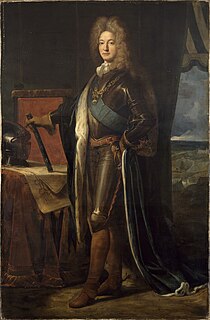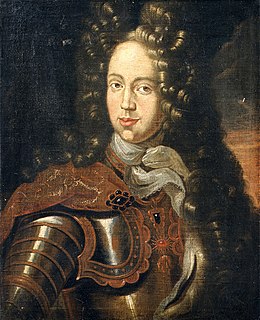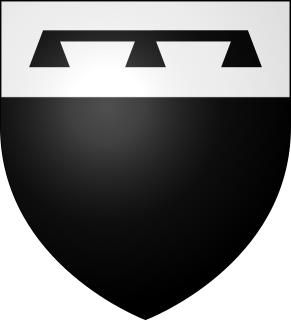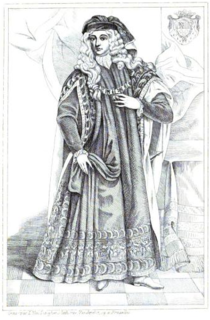Related Research Articles

1680 (MDCLXXX) was a leap year starting on Monday of the Gregorian calendar and a leap year starting on Thursday of the Julian calendar, the 1680th year of the Common Era (CE) and Anno Domini (AD) designations, the 680th year of the 2nd millennium, the 80th year of the 17th century, and the 1st year of the 1680s decade. As of the start of 1680, the Gregorian calendar was 10 days ahead of the Julian calendar, which remained in localized use until 1923.

Prince Louis of Orléans, Duke of Nemours was the second son of King Louis-Philippe I of France, and his wife Maria Amalia of Naples and Sicily.

The Distinguished Order of the Golden Fleece is a Catholic order of chivalry founded in Bruges by Philip the Good, Duke of Burgundy, in 1430, to celebrate his marriage to Isabella of Portugal. Today, two branches of the order exist, namely the Spanish and the Austrian Fleece; the current grand masters are Felipe VI, King of Spain and Karl von Habsburg, head of the House of Habsburg-Lorraine, respectively. The Grand Chaplain of the Austrian branch is Cardinal Christoph Schönborn, Archbishop of Vienna.

D. Luís Filipe, Prince Royal of Portugal, Duke of Braganza, was the eldest son and heir-apparent of King Carlos I of Portugal. He was born in 1887 when his father was still Prince Royal of Portugal and received the usual style of the heirs to the heir of the Portuguese crown: 4th Prince of Beira at birth, with the subsidiary title 14th Duke of Barcelos. After his grandfather King Luís I of Portugal died, he became Prince Royal of Portugal with the subsidiary titles 21st Duke of Braganza, 20th Marquis of Vila Viçosa, 28th count of Barcelos, 25th count of Ourém, 23rd count of Arraiolos and 22nd count of Neiva.

Adrien Maurice de Noailles, 3rd Duke of Noailles was a French nobleman and soldier.

Philippe, Duke of Orléans was the Orléanist claimant to the throne of France from 1894 to 1926.

The House of Croÿ is a family of European mediatized nobility, which held a seat in the Imperial Diet from 1486, and was elevated to the rank of Princes of the Holy Roman Empire in 1594. In 1913, the family had branches in Belgium, France, Austria and Prussia.

Prince Philippe of Belgium, Count of Flanders, was the third born and second surviving son of King Leopold I of Belgium and Louise d'Orléans.

Philippe Charles François, 3rd Duke of Arenberg was also the 9th Duke of Aarschot.

Princely Count Charles of Arenberg, duke of Aarschot, baron of Zevenbergen, knight of the Order of the Golden Fleece, was the second Princely Count of Arenberg and a leading aristocrat of the Habsburg Netherlands, who served as a courtier, soldier, minister and diplomat.

Philip II de Croÿ (1496–1549) was Seigneur de Croÿ, Count of Porcéan and first Duke of Aarschot.
Alexander von Bournonville, Alexander de Bournonville, Alexander II Hyppolite, Prince of Bournonville and third Count of Hénin-Liétard was a Flemish military man. He held the titles of Field Marshal of the Holy Roman Empire, Knight of the Order of the Golden Fleece, Viceroy of Catalonia (1678–1685) and Viceroy of Navarre (1686–1691).

John Francis Desideratus was count of Nassau-Siegen and stadtholder of Limburg and Upper Guelders.

Jean Charles Joseph, Count of Merode, Marquess of Deynze was a noble of the Austrian Netherlands, born in the Prince-Bishopric of Liège. He was Lieutenant-Feldmarschall of the Holy Roman Empire, Knight of the Order of the Golden Fleece.

John IV of Glymes, 2nd Marquess of Berghes (1528–1567), Grand Huntsman of Brabant, was a noble from the Low Countries.

Vilain and Vilain XIIII is a Belgian noble family. Their coat of arms is basically "Sable, a chief argent", a colour scheme that is present from the earliest Vilains in the 15th century, and is also seen in the Vilain XIIII arms, which have the "XIIII" added to it.

de Lannoy is the name of a Belgian noble family that takes its name from the French town of Lannoy, Nord. The name comes from l'Annoy which means «the alderwood» in Picard French of Flanders.

Philippe François de Berghes (1646–1704) was a diplomat and military commander in the Spanish Netherlands and became the first bearer of the title of prince of Grimberghen.
José Máximo Agustín De la Cerda y Palafox, 6th Marquess of Bárboles, 7th Count of Parcent, etc.,, was a Spanish aristocrat, academic and politician, member of one of the most prominent noble families in Spain, the House of De la Cerda, and who was proximate to the tendencies of Moderate Liberalism, a mid-term between reactionary liberalism and absolutism. José de la Cerda was an important figure of the early 19th century, which witnessed the development of Spanish parliamentarianism in the unstable era of transition between the Ancién Regime and Liberalism. José De la Cerda, known by his title of Count of Parcent, was a proximate figure to Queen Maria Christina, last wife of Ferdinand VII of Spain and mother and regent to Queen Isabella II. Parcent was one of the aristocrats who supported a moderate tendency of Liberalism against both the extreme versions of Liberalism and absolutism (Carlists).

Jean de Croÿ, count of Solre, baron of Molembaix and marquess of Renty, knight of the Golden Fleece, was a nobleman from the Low Countries who held high office under the Spanish Habsburgs.
References
- ↑ "Balthasar Philips de Gand Villain, prince de Masmines". Geni. Retrieved 2012-08-07.